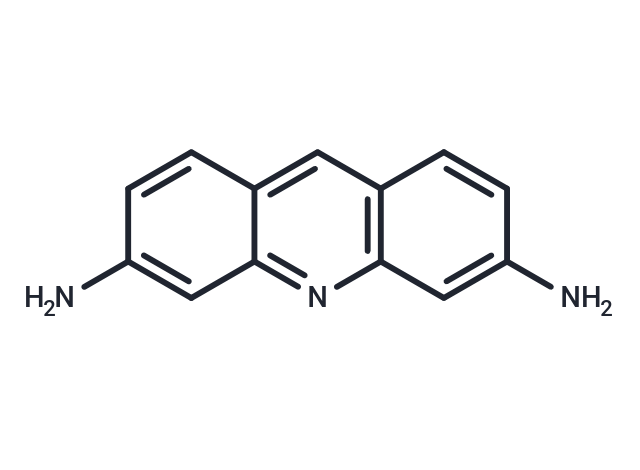Shopping Cart
- Remove All
 Your shopping cart is currently empty
Your shopping cart is currently empty
Proflavine (3,6-Diaminoacridine) (3,6-Diaminoacridine) is a disinfectant bacteriostatic against many gram-positive bacteria and is a topical antiseptic used mainly in wound dressings.

| Pack Size | Price | Availability | Quantity |
|---|---|---|---|
| 2 mg | $35 | In Stock | |
| 5 mg | $56 | In Stock | |
| 10 mg | $89 | In Stock | |
| 25 mg | $179 | In Stock | |
| 50 mg | $293 | In Stock | |
| 100 mg | $463 | In Stock | |
| 1 mL x 10 mM (in DMSO) | $59 | In Stock |
| Description | Proflavine (3,6-Diaminoacridine) (3,6-Diaminoacridine) is a disinfectant bacteriostatic against many gram-positive bacteria and is a topical antiseptic used mainly in wound dressings. |
| Cell Research | I. DNA staining and microscopic observation 1. Solution preparation: Proflavine is soluble in water and is usually prepared as a 1-10 μM solution. 2. Staining process: Add the solution to the cell culture and incubate for 10-20 minutes. After the staining process is completed, observe the distribution of DNA in the cell or tissue sample under a microscope (fluorescence microscope). 3. Fluorescence observation: After Proflavine binds to DNA, it can emit green fluorescence (λex=450 nm, λem=510 nm), which helps in cell nucleus or chromosome analysis. II. Antibacterial application 1. Solution preparation: Proflavine can be used to prepare antibacterial solutions of different concentrations, usually 0.1%-0.5% solution. 2. Treatment process: Proflavine solution can be applied to wounds, surfaces or added to culture media to inhibit bacterial growth. 3. Observation effect: The antibacterial effect is observed through bacterial culture and growth inhibition experiments. The effect is usually evaluated by culturing bacteria and observing their growth. III. Kir3.2 channel research 1. Electrophysiological experiments: Proflavine can be used to inhibit the activity of Kir3.2 channels in experiments. Electrophysiological techniques (such as patch clamp techniques) are used to study the effects of Proflavine on Kir3.2 channels in nerve cells. 2. Cell treatment: By adding Proflavine to nerve cell culture, its effects on cell electrical activity, especially the inhibitory effect on K+ currents, are observed. IV. Neurological disease research 1. Drug treatment: Proflavine can be used in pharmacological experiments to help study neurological disease models related to Kir3.2. 2. Disease models: In animal or cell models, Proflavine can be used as a tool to study the effects of drugs or treatments on these diseases. |
| Synonyms | 3,6-Diaminoacridine |
| Molecular Weight | 209.25 |
| Formula | C13H11N3 |
| Cas No. | 92-62-6 |
| Smiles | NC1=CC2=C(C=C3C(=N2)C=C(N)C=C3)C=C1 |
| Relative Density. | 1.346 g/cm3 |
| Storage | keep away from direct sunlight | Powder: -20°C for 3 years | In solvent: -80°C for 1 year | Shipping with blue ice/Shipping at ambient temperature. | |||||||||||||||||||||||||||||||||||
| Solubility Information | Ethanol: 2 mg/mL (9.56 mM), Sonication is recommended. DMSO: 11 mg/mL (52.57 mM), Sonication is recommended. | |||||||||||||||||||||||||||||||||||
Solution Preparation Table | ||||||||||||||||||||||||||||||||||||
Ethanol/DMSO
DMSO
| ||||||||||||||||||||||||||||||||||||

Copyright © 2015-2025 TargetMol Chemicals Inc. All Rights Reserved.